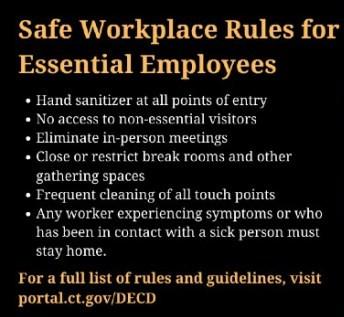Governor Lamont signed an Executive Order that builds upon his efforts to encourage mitigation strategies that slow down transmission of COVID-19. In addition to the Governors order the Department of Economic and Community Development (DECD) has revised their Safe Workplace Rules for Essential Employers
Executive Order 7BB enacts the following provisions:
Cloth face coverings or higher level of protection required in public wherever close contact is unavoidable: Effective at 8:00 p.m. on April 21, 2020, any person in a public place in Connecticut who is unable to or does not maintain a safe social distance of approximately six feet from every other person shall cover their mouth and nose with a mask or cloth face-covering.
The Commissioner of the Department of Economic and Community Development will be required to update the previously issued Safe Workplace rules (see below) and Safe Store rules.
Nothing in this order shall require the use of a mask or cloth face covering by anyone for whom doing so would be contrary to his or her health or safety because of a medical condition, anyone under the age of 2 years, or by an older child if the parent, guardian or person responsible for the child is unable to place the mask safely on the child’s face.
If a person declines to wear a mask or face covering because of a medical condition as described above, such person shall not be required to produce medical documentation verifying the stated condition.
Safe Workplace Rules for Essential Employees
 General
General
- Essential employees who are able to work from home SHOULD BE WORKING FROM HOME.
- For employees who have traveled internationally in a region where COVID-19 is active, or have returned from a cruise, it is recommended to stay home and self-monitor for fourteen days, subsequent to returning.
- Eliminate all non-essential workplace travel.
- Distribute summaries of health insurance processes and procedures to employees.
- Ensure that all employees that do not speak english as their first language are aware of procedures by communicating the procedures, either orally or in writing, in their native or preferred language.
- Ensure that the facility has a sufficient number of employees to perform all measures listed here effectively and in a manner that ensures the safety of the public and employees.
- Control access to external visitors including:
- Prohibiting entry into the facility for non-essential visitors.
- Interviewing approved visitors about their current health condition and recent travel history.
- Using soap and water or within available supplies, hand sanitizer at point of entry to the facility.
Masks or Cloth Face Coverings Required
- Each employee shall be required to wear a mask or other cloth material that covers his or her mouth and nose at all times while in the workplace. Employers shall issue such masks or cloth face coverings to their employees. In the event an employer is unable to provide masks or cloth face coverings to employees because of shortages or supply chain difficulties, employers must provide the materials and CDC tutorial about how to create a cloth face covering, or compensate employees for the reasonable and necessary costs employees expend on such materials to make their own masks or cloth face covering.
- Nothing in these rules shall require the use of a mask or cloth face covering by anyone for whom doing so would be contrary to his or her health or safety because of a medical condition.
- If a person declines to wear a mask or cloth face covering because of a medical condition as described above, such person shall not be required to produce medical documentation verifying the stated condition.
Controlling contact between employees and other employees or customers
- Companies should develop and implement practices for social distancing.
- Social distancing means avoiding large gatherings and maintaining distance (approximately 6 feet or 2 meters) from others.
- Require all customers to wear cloth face coverings while on premises. Nothing in these rules shall prohibit a business from issuing face coverings to customers or other visitors upon or prior to entry. Nothing in these rules shall require the use of a mask or cloth face covering by anyone for whom doing so would be contrary to his or her health or safety due to a medical condition, by a child in a child care setting, anyone under the age of two years, or by an older child if the parent, guardian or person responsible for the child is unable to place the mask safely on the child’s face.
- If a person declines to wear a mask or cloth face covering because of a medical condition as described above, such person shall not be required to produce medical documentation verifying the stated condition.
- In-person meetings should be avoided as much as possible. Teleconferencing may be used by site-essential staff, provided they are dialing in from separate areas. Where in-person meetings occur, they should be limited to a maximum of ten people, each attendee should have a mask covering their mouth and nose at all times, and a distance of six feet should be maintained.
- Discourage carpooling.
- Increase physical space between employees and customers (e.g., drive through, Plexiglas partitions).
- Deliver services remotely (e.g. phone, video, or web) where practical.
- Deliver products through curbside pick-up or delivery when possible.
- Workplaces with Multiple Shifts:
- Where ever possible, utilize nights and weekends to spread out work schedules and provide for social distancing.
- If possible, move from 1 or 2 shifts to 3 shifts. Keep each shift with the same people each day. That way, if a person on one shift becomes sick, workers on the other shifts are protected. This arrangement can also work by having one crew work for part of the week and one crew for the other part of the week. This may also accommodate shifting child care schedules.
- Provide time where possible between each work shift to minimize overlap and allow for cleaning of the work environment at regular and appropriate intervals.
- Stagger shift start/stop times, break times, and lunchtimes to minimize congregations at the time clocks or break areas.
- Where possible, close or restrict break rooms and cafeterias and have employees bring lunches from home and eat at workstation or in cars.
- If an employer does maintain break or lunch rooms, utilize extra rotations to reduce the number of employees in the break room/cafeteria at one time to achieve social distancing norms. Provide soap and water, or within available supplies, hand sanitizer and/or disposable wipes in break or lunch rooms and clean them after every shift.
- Increase ventilation rates and increase the percentage of outdoor air that circulates into the system where possible.
- Wherever possible, segment the workspace into discrete zones. Prohibit employees from entering into zones where they are not required to be to perform their jobs.
- Manufacturing – Shutdown the facility when production is not needed whenever practical (even if you ramp on and off on a daily basis).
Eliminating transmission points
- Reduce common touch points by opening internal doors where possible.
- Install all no-touch disposal receptacle or remove lids that require contact to open for non-hazardous waste containers unless doing so creates an unsanitary environment.
- Frequent cleaning of all touch points.
- Secure all secondary doors and access points to minimize incidental contact.
- Recommended to provide disposable wipes so that commonly used surfaces (for example, doorknobs, keyboards, remote controls, desks, other work tools and equipment) can be wiped down.
- To disinfect surfaces, use products that meet EPA’s criteria for use against SARS-Cov-2and are appropriate for the surface.
- Prohibit workers from using other workers’ phones, desks, offices, or other work tools and equipment, when possible. If shared, clean and disinfect equipment before and after use.
- Employees should clean their personal workspace at the beginning and the end of every shift.
- If a sick employee is suspected or confirmed to have COVID-19, follow the CDC cleaning and disinfection recommendations.
Guidelines for essential employees
- Employees who are ill should stay home.
- Where possible, employees should take their temperature before they go to work. If they have a temperature above 100.4 degrees Fahrenheit, they should stay home.
- Make hand sanitizer available to employees who do not have ready access to soap and water.
- Place posters that encourage hand hygiene to help stop the spread at the entrance to your workplace and in other workplace areas where they are likely to be seen.
- Whether at work or at home, all employees are advised to follow the CDC guidelines for preventing transmission of COVID-19 including:
- Washing hands frequently for at least 20 seconds, avoiding touching mouth and nose, avoiding close contact with others, cleaning and disinfecting surfaces, using cough and sneeze etiquette, and staying at home when sick.
Guidelines for employees who had close contact with a person with symptoms of or have been diagnosed with COVID-19:
- Specific guidance for healthcare workers and first responders can be found here.
- Do not go to work.
- Notify your supervisor
- Isolate yourself from the rest of the people in your home.
- Consult your healthcare provider.
- Practice home isolation as recommended by your health care provider.
Guidelines for workplace illness:
Guidelines if an employee is exposed to or diagnosed with COVID-19:
- Employees who have symptoms (i.e., fever, cough, or shortness of breath) should notify their supervisor and stay home.
- Sick employees should follow CDC-recommended steps. Employees should not return to work until the criteria to discontinue home isolation are met, in consultation with healthcare providers and state and local health departments.
- Employees who are well but who have a sick family member at home with COVID-19 should notify their supervisor and follow CDC recommended precautions.
- If an employee is confirmed to have COVID-19 infection, employers should:
- inform fellow employees of their possible exposure to COVID-19 in the workplace but maintain confidentiality as required by the Americans with Disabilities Act (ADA). The fellow employees should then self-monitor for symptoms (i.e., fever, cough, or shortness of breath).
- Ventilate areas visited by that individual.
- Clean and disinfect all impacted spaces, especially commonly used rooms and shared equipment.
- Employees should not return to work until the criteria to end home isolation is met as instructed in consultation with healthcare providers and state and local health departments.
